-

人教版新课标PEP小学英语三年级下册At the zoo教案3篇
(二) 呈现新课 (Presentation)1、教师出示学过的缩略语PRCUKCANUSA让孩子读一读,然后拿出相应的卡片贴在黑板上请掌握较好的学生带着同学们读一读缩略语2、出示课文中的缩略语,让孩子们自己试着读一读,然后试着说说缩略语的含义3、听录音,跟读。小组说说4、让孩子们介绍自己收集的生活中的缩略语教师给以适当的扩充:CCTVWTOUFO等5、教师分别出示大小写Hh,让孩子想想大小写的字母分别想什么,用语言描述或是用动作表示。6、Let’s chant听录音,边听边打节奏听录音,边听边出示相应的字母听录音,边听边试着说歌谣孩子们带上自己的头饰,在小组中边演边说各小组展示(三)趣味操练(Practice)1、listen and order the cards让孩子说字母,按照听到的顺序排列字母2、listen and guess教师拼一拼缩略语,孩子快速说出词小组游戏(四) 扩展性活动(Add-activities)纸牌游戏两个孩子分别有一套学过的字母卡,按顺序出卡片,看谁能最先组成一个学过的缩略语。【板书设计】
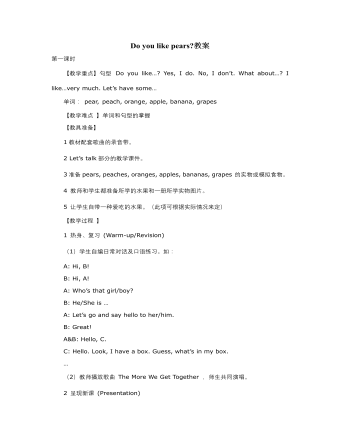
人教版新课标PEP小学英语三年级下册Do you like pears教案
教师扮做客人,让孩子根据问题做出反应并回答。 Can I have an apple? Can I have some grapes? Let’s sing 播放歌曲的录像,先观看一遍, 帮助孩子理解歌曲。 孩子边唱边表演。 小组表演,小组展示。 (四) 扩展性活动(Add-activities) Coloring Draw some grapes, color them red Draw a banana,color it green. …, …【板书设计 】Do you like pears? Do you like pears? 第五课时第六课时【课题】Do you like pears? 第六课时 【教学重点】听、说、认读字母Rr Ss Tt,体会字母在单词中的发音 【教学难点 】字母Ss的发音。Tiger中字母I的发音 【教具准备】 1、本课生词的单词卡片 2、配套的教学课件 3、相配套的教学录音带 4、学生的小英语练习本 5、大字母卡片,每组一套的小字母卡片 【教学过程 】 (一)热身/复习(Warm-up/Revision) 1、Let’s sing 演唱B部分的歌曲,边唱边演。
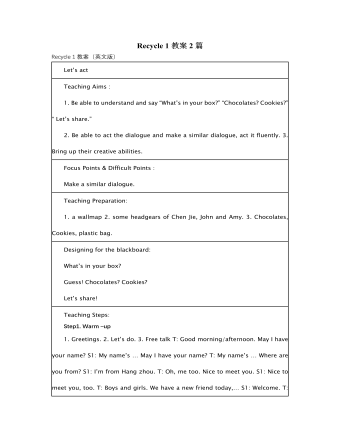
人教版新课标PEP小学英语三年级下册Recycle 1教案2篇
1.猜袋中东西数 将全班分成若干小组,每组抽一人到前面,背对着班级。教师拿一个袋子,并向学生们借一些书本,铅笔,钢笔,橡皮等,放入袋中,然后让各组学生轮流猜袋子里东西的数目,猜对的给该组记10分。 2.学生一起有节奏地说唱Let’s chant部分的歌谣,并请学生分角色表演。 (二)呈现新课 (Presentation) 1.抢读单词 教师将全班分成若干小组,然后逐个出示一些图片,学生们举手抢答,教师让最先举手的学生将图片的单词说出来,说对的给该组记10分,得分最多的组为优胜。 2.看单词卡读出单词并说出中文,复习1-3单元要求四会的单词。 3.教师用实物投影出示1-3单元课文中的某一幅图片,让学生根据图片内容进行对话练习。 4.让学生填写Assessment部分的内容,自己对1-3单元所学内容的掌握情况进行自我评价。 5.教师向学生出示已制作好的window card:This si a window card.并教读window card教师问学生:Do you like it? Can you make it? Do you want to learn how to make a window card?
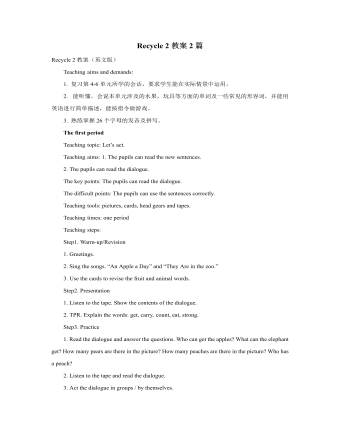
人教版新课标PEP小学英语三年级下册Recycle 2教案2篇
第三课时教学设计方案【教学内容和目标】【教学重点】 制作键盘; 学唱英文歌曲 “A B C Song ”。【教学难点】复习过程中的兴趣培养;【教具准备】1 教材配套的录音带。2 教师和学生分别准备废旧的硬纸盒/纸版、剪刀、胶水。3 教师准备一个自己已制作好的键盘。4 教师准备字母卡片和真正的键盘一个。【教学过程】1 热身、复习 (Warm-up/Revision)(1)师生之间进行英语对话或进行日常口语活动。(2)学生之间自编对话并表演。(3)教师播放B Let’s chant 的录音,让学生边拍手边说歌谣。(4)游戏:Silent Speech教师换一种方法说字母------唇说,说字母的时候不发出声音。学生看教师的口形,猜教师“说”的内容。说的字母为Aa----Zz 。2 呈现新课 (Presentation)(1)教师出示字母卡片,学生认读字母Aa----Zz。(2)学生字母背诵Aa----Zz。(3)教师播放歌曲 “A B C Song ”,告诉学生“试一试”“比一比”,看看谁能通过自己试唱学会歌曲。
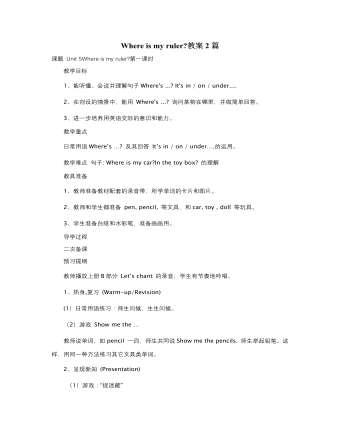
人教版新课标PEP小学英语三年级下册Where is my ruler教案2篇
1.Let’s say学习字母Uu, Vv, Ww,以及以这些字母开头的单词。2.Let’s do本部分通过有韵律的歌谣,来复习巩固A-W的字母。【教学重点】学习字母Uu, Vv, Ww及以其为首字母的单词【教学难点】单词umbrella, violin, wind和字母Uu, Vv, Ww的发音.【教具准备】1 教师准备教材配套的录音带。2 教师准备 umbrella, vest, violin, window, wind 的图片和词卡。3 教师准备字母卡 Aa----Ww 。【教学过程】1 热身、复习 (Warm-up/Revision)(1)Oral practice学生口语会话展示。教师可根据学生情况提示他们增加对内容。(2)游戏:“猜猜看”。教师用简笔画的方法在黑板上画某种交通工具的某个部位,边画边问:What is it? 学生随意想象,猜图说:A panda? A jeep? A pear? … 教师再继续画一两笔,让学生接着猜,并以小组为单位讨论,最后由一名学生代表说出一个答案。教师将图画完,带领学生一起说: Look! It’s a … 猜对的小组赢得一分。(以交通工具、玩具和文具词为主) 还可让学生代替教师进行此项活动。
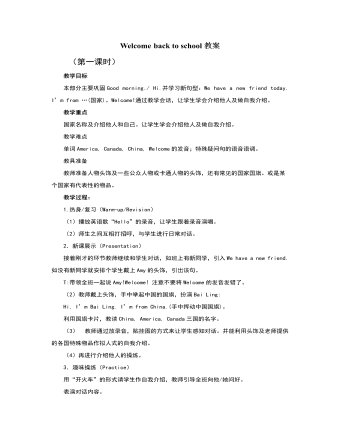
人教版新课标PEP小学英语三年级下册Welcome back to school教案
教学过程:1.热身/复习(Warm-up/Revision)(1)教师用肢体语言表示出字母,让学生猜出字母,并大声读出。(2)出示字母卡,学生认读,并提问学生回忆以它开头的单词。(3)放A部分Let’s chant的录音,学生有节奏地跟唱歌谣。2.新课展示(Presentation)(1)出示字母卡学习Dd,再单独呈现大写或小写,反复教读。用同样方法教读Ee。(2)出示以这两个字母为首字母的单词图片,问学生:What’s this ?回答:It’s a duck .教读duck,dog,egg,elephant。注意egg是an egg,不是“a egg”.(3)放Let’s say部分的录音,学生跟读。3.趣味操练(Practice)(1)呈现大写或小写字母的趣味图片,让学生认读。(2)让学生发挥想象,说出这些字母 像什么。(3)教师按笔顺书写字母,让学生观察后按笔顺书写字母。(4)游戏:找朋友游戏:看谁站得快学生手执卡片,听教师发令后,产成一排,下面的学生边读边检查。
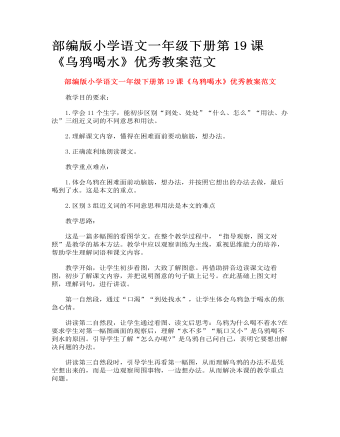
部编版小学语文一年级下册第19课《乌鸦喝水》优秀教案范文
教学思路: 这是一篇多幅图的看图学文。在整个教学过程中,“指导观察,图文对照”是教学的基本方法。教学中应以观察训练为主线,重视思维能力的培养,帮助学生理解词语和课文内容。 教学开始,让学生初步看图,大致了解图意。再借助拼音边读课文边看图,初步了解课文内容,并把说明图意的句子做上记号。在此基础上图文对照,理解词句,进行讲读。 第一自然段,通过“口渴”“到处找水”,让学生体会乌鸦急于喝水的焦急心情。 讲读第二自然段,让学生通过看图、读文后思考:乌鸦为什么喝不着水?在要求学生对第一幅图画面的观察后,理解“水不多”“瓶口又小”是乌鸦喝不到水的原因。引导学生了解“怎么办呢?”是乌鸦自己问自己,表明它要想出解决问题的办法。 讲读第三自然段时,引导学生再看第一幅图,从而理解乌鸦的办法不是凭空想出来的,而是一边观察周围事物,一边想办法。从而解决本课的教学重点问题。

人教版新目标初中英语九年级下册By the time I got outside, the bus had already left教案
Ⅰ. Teaching Aims and Demands1. Knowledge Objects(1) Key Vocabularyoversleep(2) Target LanguageWhat happened?I overslept. And by the time I got up, my brother had already gotten in the shower.2. Ability Objects(1) Teach the students to use the new words.(2) Train the students to narrate past events with the Past Perfect Tense.(3) Train the students' listening and speaking skills with the target language.3. Moral ObjectIt’s a good habit to go to bed early in the evening and get up early in the morning. So you’ll never be in a hurry in the morning.Ⅱ. Teaching Key Points1. Key Vocabularyoversleep2. Target LanguageNarrate past events with the Past Perfect TenseⅢ. Teaching Difficult Points1. Train the students to narrate past events with the Past Perfect Tense.2. Train the students to understand the target language in spoken conversation.Ⅳ. Teaching Methods1. Thinking of examples from the students' real lives.2. Making sentences by looking at the pictures.Ⅴ. Teaching AidA tape recorderⅥ. Teaching ProceduresStep I Revision1. Revise the language points in Unit 8.Ask some questions like this: What volunteer work would you like to do?Help the students to answer, I’d like to…/I love to…/I hope to2. Practice the dialogue in Activity 3c on page 62 again. Get students to role play the similar dialogues with the following.

人教版新目标初中英语九年级下册Rainy days make me sad教案
1. 教材分析本单元以how do things affect you?为话题, 从颜色、天气、音乐、广告、产品等方面谈论了外界事物如何影响人的心情。要求学生掌握表达某物或某事给人带来的感觉、看法或影响等。共设计了四个部分的内容:Section A 该部分有4个模块:第一模块围绕Which restaurant would you like to go to?这一话题展开思维(1a)、听力(1b)、口语(1c)训练;第二模块围绕How does music affect you? 进行听力(2a-2b)、口语训练(2c);第三模块继续围绕how do colors in the restaurant affect you这一话题展开训练,训练形式为阅读和问题体验(3a)和小组活动(3b);第四模块仍就How do things affect you这一话题以调查的形式展开讨论。Section B该部分有4个模块:第一模块围绕产品广告对人们的影响这一话题以“配对”(1a)与“列举”(1b)两种形式展开训练;第二模块继续围绕How do things affect you? 进行听力(2a-2b)、口语对话训练(2c);第三模块围绕“Advertising”这一话题展开阅读(3a-3b)和写作(3c)训练;第四模块围绕How posters affect you这一话题以口语训练形式展开小组活动。

人教版新目标初中英语九年级下册Could you please tell me where the restrooms are教案
Step Ⅰ RevisionCheck homework. Ask a few students to read the article in 3a.Then ask a few students to read their guides.Step Ⅱ Part 1Look at the words in the box. Ask a student to read them. Make sure the students understand the meaning of the words. You are to fill in the blanks with the words. In some cases, students may need to use another form of the word, for example adjusting for tense or subject/ verb agreement.Ask students to fill in the blanks on their own.Check the answers. Step ⅢPart 2Go through the instructions with the class.Look at the example with the students.Ask students what the answer would be.Ask a student to read the question and answer it.Excuse me, could you tell me where the bank is, please?The bank is across the street from the shopping malt.Get students to complete the work in pairs.Check the answers. Ask a few students to read their questions.Step Ⅳ Just for Fun!Ask all the students to read the conversation. Ask: What is funny about this cartoon? Help students to explain. A Martian is a person from the planet Mars.There is no such thing as Martian food on Earth, and the clerk looks silly because he is trying to think of where there is a Martian restaurant.Invite some pairs of students to present this conversation to the rest of the class.Step Ⅴ Summary and HomeworkIn this class, we’ve done much writing practice using the key vocabulary words and the target language presented in this unit. After class, please finish the questions in 2 in your exercise books. Then finish the exercises on pages 47~48 of the workbook as well.The Seventh Period Ⅰ Teaching Aims and Demands1. Knowledge Objects(1) Key Vocabularyimage, adventure, jealousy, hero, crime, journey, brave, no longer, show interest in, take it easy, become interested in, plain looks(2)Text:Grown-ups like cartoons, too.2. Ability Objects(1) Fast-reading to get a general idea of the text.(2) Careful-reading to get the detailed information in the text.

人教版新目标初中英语九年级下册I’ll help clean up the city parks教案
Talk about offering help (P60)I’ll help clean up the city parks.A: I’d like to work ...B: You could help ...Talk about ways to tell people about the Clean-Up Day (P61)We need to ...We can’t ...I’ll ...Talk about the work the volunteers do (P62)These three students all volunteer their time to help other people.Somebody loves to ... / helps ... / plans to ... / wants to ...A: What do you like doing?B: I like ... A: What kind of volunteer work do you think I could do?B: You could ...1. 重点词汇advertisement, fix, repair, pleasure, blind, deaf, shut, carry, specially, fetch2. 认读词汇hunger, homeless, cheer, clean-up, sign, establish, major, commitment, elementary, veterinarian, coach, similar, call-in, strategy, disabled, organization, unable, support, appreciate, donation, part of speech, pronoun, adverb, preposition, conjunction, donate, Jimmy, Sally3. 词组clean up, cheer up, give out, put off, set up, think up, take after, fix up, give away, put up, hand out, work out, at once

人教版新目标初中英语九年级下册We’re trying to save the manatees教案2篇
本单元主要围绕着有关濒临灭绝的动物这一话题,学习了应该怎样保护我们的环境,以及就某一问题展开辩论。目标提示语言目标能够运用所学知识,就某一问题展开辩论。认知目标1、复习一些语法:现在进行时、一般现在时、用used to 表示一般过去时、现在完成时、一般过去时的被动语态。2、学会表达同意和不同意。3、学会以下基本句型:We’re trying to save the manatees.Manatees eat about 100 pounds of food a day.There used to be a lot of manatees.In 1972,it was discovered that they were endangered.Some of the swamps have become polluted.情感目标了解一些濒临灭绝的动物的生活习性和濒临灭绝的原因,教育学生应该如何保护环境。教学提示充分利用多媒体等教学设备,创设与本课话题相关的情境,如各种不同种类的动物、动物园以及有关环境的画画等等。围绕着本单元的教学目标,设计一些贴近学生实际的教学任务,如让学生谈论自己最喜欢的动物,如何拯救濒危动物,如何保护环境等等。让学生根据所学知识,就动物园是否对动物有利以及其他的话题进行辩论。

人教版新目标初中英语九年级下册You’re supposed to shake hands教案
教学目标:1. 掌握本单元一些重点词汇的写法和用法。2. 学会自如谈论餐桌礼仪。Step 1 RevisionAsk some students to retell the customs at the table in France in the passage in 3a.Step 2 Self checkPart 1. Fill in each bland with the correct word given. Students do the exercises by themselves at first. Then check the answers. Ask the students to comprehend the sentences and help them point out uses of some words, like “arrive (at / in) sw., spend time / money on sth , spend time / money (in) doing sth.”Part 2. Read about Fan Ling’s experience in a western restaurant. Understand the passage. Point out some key points in the passage.1. be / get used to doing sth. 习惯做某事2. begin with = start with 以….开头3. crowd v. 挤满,塞满 the crowd 人群 crowded adj. 拥挤的Then students discuss about how she would solve her problem. Ask some to share their stories with others.Part 3. Complete the crossword by looking at the sentences on the left. Then check the answers.
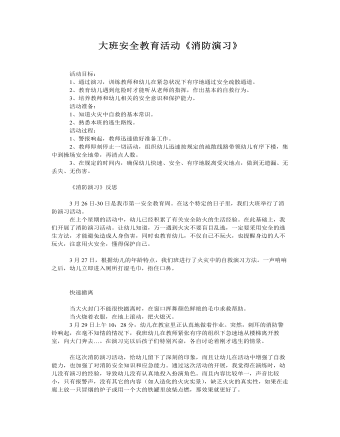
大班安全教案:消防演习
2、教育幼儿遇到危险时才能听从老师的指挥,作出基本的自救行为。 3、培养教师和幼儿相关的安全意识和保护能力。 活动准备: 1、知道火灾中自救的基本常识。 2、熟悉本班的逃生路线。 活动过程: 1、警报响起,教师迅速做好准备工作。 2、教师即刻停止一切活动,组织幼儿迅速按规定的疏散线路带领幼儿有序下楼,集中到操场安全地带,再清点人数。 3、在规定的时间内,确保幼儿快速、安全、有序地脱离受灾地点,做到无遗漏、无丢失、无伤害。
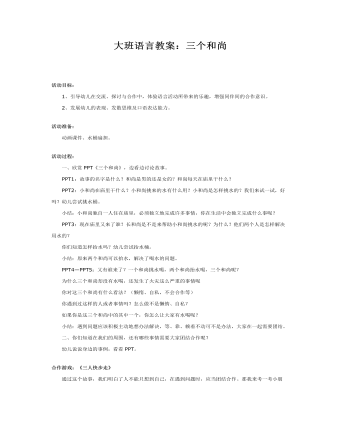
大班语言教案:三个和尚
2、发展幼儿的表现、发散思维及口语表达能力。活动准备: 动画课件、水桶扁担。活动过程: 一、欣赏PPT《三个和尚》,边看边讨论故事。PPT1:故事的名字是什么?和尚是男的还是女的?和尚每天在庙里干什么?PPT2:小和尚在庙里干什么?小和尚挑来的水有什么用?小和尚是怎样挑水的?我们来试一试,好吗?幼儿尝试挑水桶。 小结:小和尚独自一人住在庙里,必须独立地完成许多事情,你在生活中会独立完成什么事呢?PPT3:现在庙里又来了谁?长和尚是不是来帮助小和尚挑水的呢?为什么?他们两个人是怎样解决用水的? 你们知道怎样抬水吗?幼儿尝试抬水桶。 小结:原来两个和尚可以抬水,解决了喝水的问题。
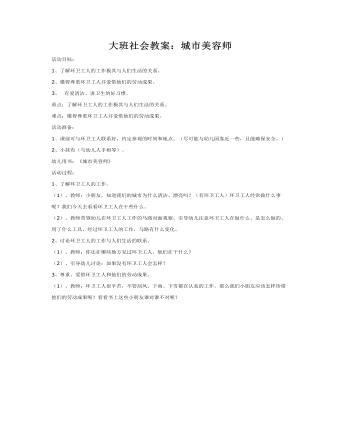
大班社会教案:城市美容师
1、了解环卫工人的工作极其与人们生活的关系。 2、懂得尊重环卫工人并爱惜他们的劳动成果。 3、 有爱清洁、讲卫生的好习惯。 重点:了解环卫工人的工作极其与人们生活的关系。 难点:懂得尊重环卫工人并爱惜他们的劳动成果。 活动准备: 1、课前可与环卫工人联系好,约定参观的时间和地点。(尽可能与幼儿园靠近一些,且能确保安全。) 2、小抹布(与幼儿人手相等)。 幼儿用书:《城市美容师》 活动过程:
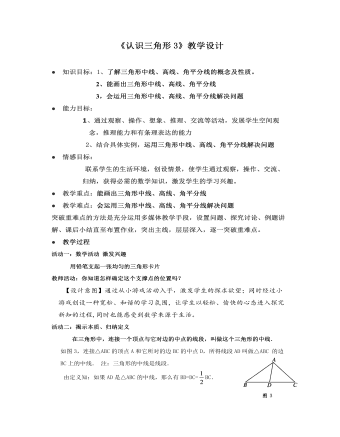
认识三角形教案教学设计
四个同学为一个合作小组;每个小组利用教师为其准备的各类三角形,作出它们的高.比一比,看哪一个小组做得最快,发现的结论多. 师生行为:学生操作、讨论,教师巡视、指导,使学生理解【设计意图】通过让学生操作、观察、推理、交流等活动,来培养学生的动手、动脑能力,发展其空间观察.活动结论:1.锐角三角形的三条高都在三角形内; 2.直角三角形的一条高在三角形内(即斜边上的高),而另两条高恰是它的两条直角边; 3.钝角三角形的一条高在三角形内,而另两条高在三角形外.(这是难点,需多加说明) 总之:任何三角形都有三条高,且三条高所在的直线相交于一点.(我们把这一点叫垂心)课堂小结 1.三角形中三条重要线段:三角形的高、中线和角平分线的概念. 2.学会画三角形的高、中线和角平分线.
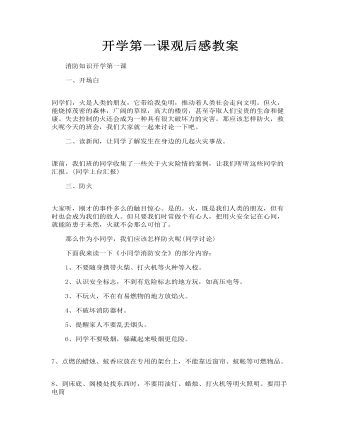
开学第一课观后感教案
三、防火 大家听,刚才的事件多么的触目惊心。是的。火,既是我们人类的朋友,但有时也会成为我们的敌人。但只要我们时常做个有心人,把用火安全记在心间,就能防患于未然,火就不会那么可怕了。 那么作为小同学,我们应该怎样防火呢(同学讨论) 下面我来读一下《小同学消防安全》的部分内容: 1、不要随身携带火柴、打火机等火种等入校。 2、认识安全标志,不到有危险标志的地方玩,如高压电等。 3、不玩火,不在有易燃物的地方放焰火。 4、不破坏消防器材。 5、提醒家人不要乱丢烟头。 6、同学不要吸烟,躲藏起来吸烟更危险。
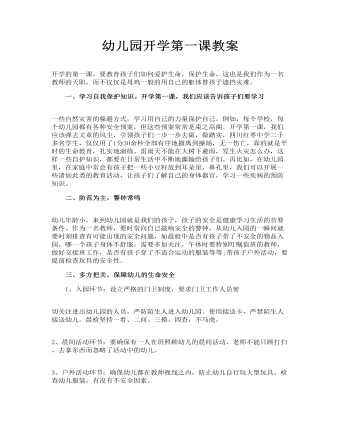
幼儿园开学第一课教案
二、防范为主,警钟常鸣 幼儿年龄小,来到幼儿园就是我们的孩子,孩子的安全是健康学习生活的首要条件。作为一名教师,要时常向自己敲响安全的警钟,从幼儿入园的一瞬间就要时刻排查有可能出现的安全问题,如晨检中是否有孩子带了不安全的物品入园,哪一个孩子身体不舒服,需要多加关注,午休时要特别叮嘱值班的教师,做好交接班工作,是否有孩子穿了不适合运动的服装等等;带孩子户外活动,要提前检查玩具的安全性。

幼儿园大班教案:顺数与倒数
【活动重点】 理解顺数与倒数的内在规律。 【活动难点】 学习倒数、倒接数 【活动准备】 1、1—10磁性数字卡2套、方向箭头1个 2、青蛙10个,荷叶若干个 3、相同火车头图片2个(区别:车牌号不同) 4、高楼模型1栋、1—10粘贴数字1套 5、《开火车》音乐 【活动过程】一、开始部分: (一)教师自我介绍,表达认识新朋友的愉悦心情。 (二)教师以谈话的方式,导入青蛙,及要去参观青蛙的新楼房的主题,吸引幼儿的注意力和参与活动的积极性。 (三)教师与幼儿共同游戏进行知识铺垫。 1.通过拍手游戏感知数量之间多1与少1的关系。 2.数字感知多1与少1的关系:如:比2多1的数是几?比9少1的数是几?

